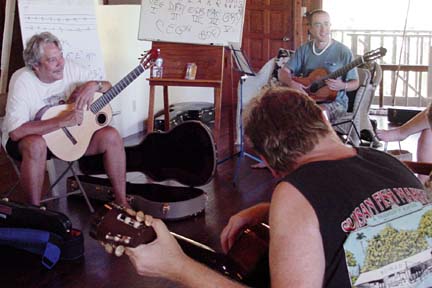
ASSOCIATED PRESS / 2003
Slack key has gained a wide audience, with guitarists as far as Germany and Japan picking up the style. Here, during a class in Kalapana, Hawaii, slack-key guitar instructor Keola Beamer answers questions from attendees.
Slack-key guitarists
perpetuating
the traditionKeola Beamer helped revive
the indigenous sound in the 1970s
PAHOA, Hawaii >> Keola Beamer remembers, as a small boy, hearing the sound of a guitar, but it was a sound that was quite different. It was softer, gentler, sweeter.
"An old man was sitting on an oil can and playing with his eyes closed," said the songwriter and recording artist.
What Beamer heard was the unique sound of the Hawaiian slack-key style of guitar playing known as ki ho'alu, which means "loosen the key."
Slack key gained a wider audience when pianist George Winston, of Dancing Cat Records, began recording Beamer and other artists, with international distribution.
Now, some guitarists on the mainland and as far away as Germany and Japan are picking up the style.
Normally, all of the guitar strings are slackened, but it varies, Beamer said. Some artists play with only some loose strings.
The right-hand strings are plucked, rather than strummed, said Mark Nelson, a Jacksonville, Ore., recording engineer and guitar teacher. "Slack key is primarily a finger-picked, melodic style," he said.
Slack key players aim for a sound that is a soft breeze, or caress, reminiscent of the weather in Hawaii, what the Hawaiians call "nahenahe," Nelson said.
Hawaiian slack key is basically a method of playing guitar using nontraditional tunings, said Beamer.
"There are about 40 different tunings we use, and each has a different coloration," he said. "Part of the art of playing slack key is to match the tuning to the material or the song."
The most common tuning is open G, also known as Taropatch. It has a DGDGBD tuning rather than the standard EADGBE. Another common tuning is the DGDFBD double slack, also known as G wahine or Namakelua's tuning, used by a Beamer mentor, the late Aunty Alice Namakelua.
"It's Hawaiian even though some of the tunings are common to other traditions," said Nelson. "The difference to a large extent is the feel and the repertoire of classic slack-key songs."
Pat Cockett, a Kauai guitarist and recording artist, agrees there is much more to the style than loose strings.
"In addition to the slackened strings, it's the way you play," he said. "It's a way of playing that's Hawaiian."
Slack key originated with the paniolos, or cowboys, in the Kamuela area of the Big Island in the early 1800s, Beamer said. Originally, it was used to accompany hula dancers.
"Slack-key guitar used hula rhythms, the rhythms of the heart," said Beamer's wife, Moana, a kumu hula.
"Hula and slack key are intertwined," she said. "Slack key owes a lot to hula."
But like hula and many expressions of Hawaiian culture, slack key began to fade.
"Part of the reason is that the Hawaiians had lost so much that was central to their lives," Beamer said. "As a consequence, many things went underground for a while."
Slack key began to die because "it was so underground and so cultist," Beamer said.
"Tunings were passed on father to son and never outside the family," he said. "It was a small world with no new players. There was no place to go and hear it, no recordings and no places to learn."
Beamer recalls that the old man he heard playing as a boy stopped playing when he saw the boy and turned his back on him. "I was not family to him," he said.
Slack key started resurfacing in the 1950s and 1960s. Beamer credits native Hawaiians.
"They realized something we love we were starting to lose," he said.
At the forefront was the late Gabby Pahinui, often referred to as "the father of modern slack-key guitar," who first recorded his signature tune "Hi'ilawe" in 1947. He established slack key as a solo guitar style.
By the early 1970s a couple of recordings helped spark the revival, including Beamer's own "Hawaiian Slack Key in the Real Old Style."
Beamer also wrote the first method book for slack key in 1973. He later collaborated with Nelson, who also plays guitar professionally, on a second book.
Nelson had heard a lot of slack key in Southern California but did not know what it was. "Then I heard Keola's first album and knew that was it," he said.
He borrowed the album and tried to teach himself, but did not really learn until the early 1990s when he came to Hawaii.
"The key was seeing and hearing Raymond Kane. He's my teacher, but he doesn't know who I am," Nelson said of one of the slack-key kupuna.
The resurgence of slack key was part of the Hawaiian renaissance of the 1970s, when Hawaii's native people returned to their cultural roots. Part of that resurgence included Keola teaming with his brother, Kapono, to form the Beamer Brothers for recordings and concert appearances.
Former residents who left the islands in the 1990s outmigration "became the core of our audiences," said Beamer, who has toured on the mainland.
"Slack key on the mainland is Hawaiian slack key with some variations," Beamer said. "They (mainlanders) like the expressiveness of it. It opens doors for them."
The appeal is also spreading internationally.
Aki Shimura first heard slack key while a student at the University of Hawaii, but he did not start playing until he returned to Japan. He learned from Beamer's book and a professional player, and found it not as difficult as he thought.
"Life in Japan is busy and slack key is very relaxing," said the Tokyo resident, who attended Beamer's recent Aloha Music Camp.
"Slack key seems so natural to me," said Angela Goebel, of Hamburg, Germany, also a student at the camp.
